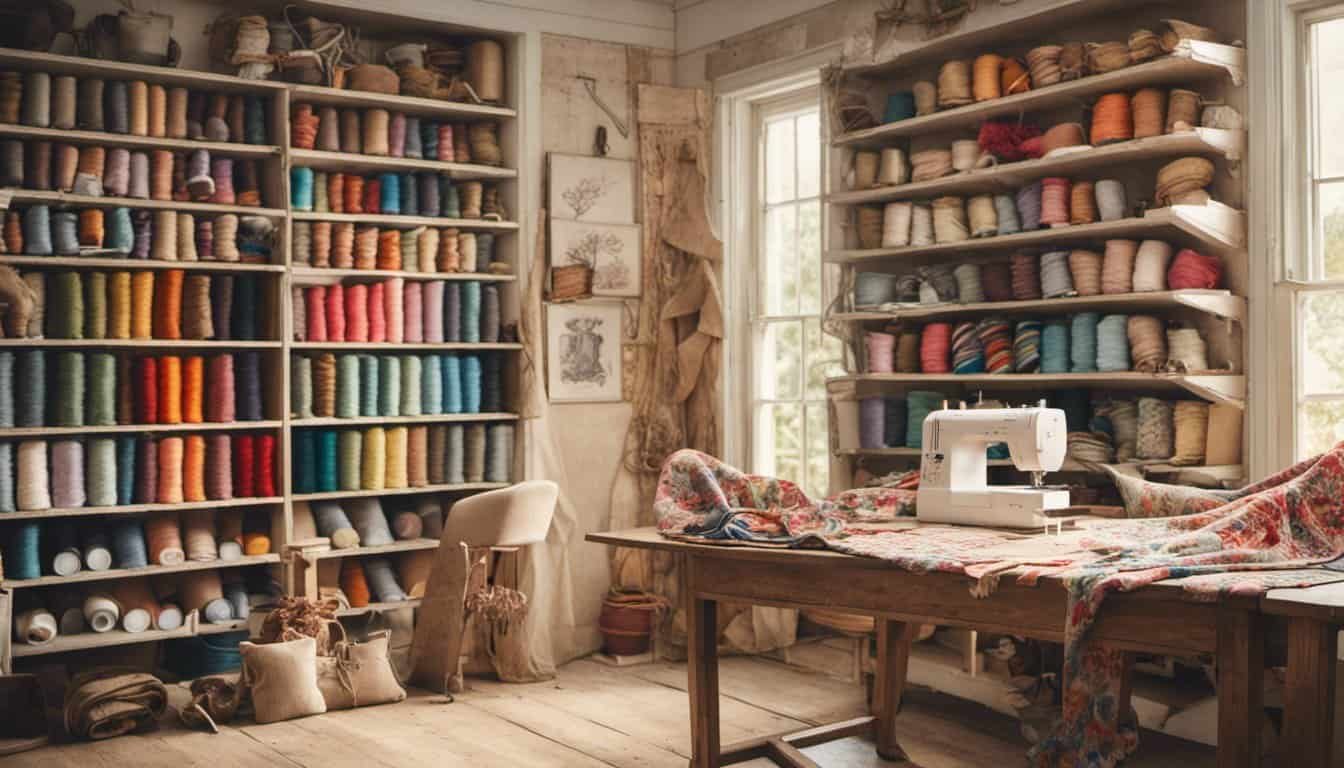Ever wondered how sewing machine tables make your stitching projects smoother and more efficient? These specialized tables aren’t just surfaces to place your machine on—they’re designed to enhance your sewing experience. From providing stability to offering convenient storage, sewing machine tables are a game-changer for both hobbyists and professionals alike.
Understanding Sewing Machine Tables
Sewing machine tables significantly improve your sewing experience by offering stability, storage, and ease of use. Various types and key features enhance their functionality.
Types of Sewing Machine Tables
- Portable Tables
Portable tables are lightweight, foldable, and easy to store. Ideal for those with limited space, they can be set up and packed away quickly. Example: IKEA has models designed for small apartments. - Built-In Cabinets
Built-in cabinet tables come with integrated storage solutions. They often include drawers, shelves, and extendable work surfaces. Example: Arrow Cabinets produces a range of these, perfect for elaborate projects. - Adjustable Height Tables
Adjustable height tables can be raised or lowered to fit your ergonomic needs. These tables are suitable for users of different heights. Example: Gidget II offers models with height adjustment features. - Quilting Tables
Quilting tables have extended surfaces to accommodate large quilts. These tables provide the necessary space to manage bulky projects. Example: Sew Ready Comet is known for spacious quilting tables.
- Stability
Stability comes from solid construction and non-slip feet. It ensures that your machine stays in place. Look for tables with reinforced legs and sturdy surfaces. - Storage
Storage features include drawers, cabinets, and side pockets. They help keep your tools and fabrics organized and within reach during projects. - Extension Leaves
Extension leaves allow you to expand your workspace easily. They fold out when needed and retract when not in use, ideal for small spaces. - Cable Management
Cable management systems keep your power cords and foot pedal wires organized. This prevents tangling and clutter on your workspace. - Surface Material
Surface material impacts the durability and smoothness of your working area. Laminate, wood, and metal surfaces are common choices. - Foldability
Foldability is crucial for portable and space-saving tables. This feature enables you to pack away the table when not in use, maximizing your room space.
Benefits of Using Sewing Machine Tables
Sewing machine tables offer numerous advantages that elevate your sewing experience.
Ergonomics and Comfort
Sewing machine tables improve ergonomics and comfort. Proper height adjustment reduces physical strain. Features like adjustable surfaces and cushioned edges enhance comfort during long sewing sessions. Ergonomic designs help maintain good posture, preventing discomfort and injury.
Increased Efficiency in Sewing Projects
Sewing machine tables increase efficiency in sewing projects. Integrated storage compartments keep tools organized and accessible. Large workspaces accommodate fabric, patterns, and accessories, streamlining your workflow. Extension leaves provide extra surface area for larger projects, ensuring seamless and productive sewing sessions.
Selecting the Right Sewing Machine Table
Choosing the right sewing machine table enhances your sewing experience, ensuring efficiency and comfort.
Factors to Consider
You should consider several key factors when selecting a sewing machine table. First, assess the table’s stability. A stable table minimizes vibrations, helping you achieve precise stitches. Tables with sturdy legs and solid construction work best (e.g., models like IKEA’s portable ones).
Second, evaluate the available workspace. A larger workspace supports bigger projects, such as quilts. Look for tables with extension leaves or additional surfaces, like the Sew Ready Comet, to increase your working area.
Third, think about storage. Integrated storage compartments help organize tools and materials, boosting efficiency. Options like Arrow Cabinets offer built-in drawers and shelves for convenient storage.
Fourth, prioritize ergonomic design. Adjustable height tables, like the Gidget II, allow you to sew comfortably without straining your body. Ergonomic features improve posture, reducing physical strain during long sewing sessions.
Lastly, consider portability. If you frequently move your sewing setup, opt for foldable or portable tables. Lightweight tables with easy folding mechanics are ideal for limited spaces.
Recommendations for Different Sewing Needs
Your specific sewing needs dictate the best table choice.
For general sewing, choose a table with a moderate workspace, stability, and basic storage. Models such as IKEA’s portable tables fit well.
If you focus on quilting, look for tables with expansive workspaces and extension options. Quilting tables like the Sew Ready Comet provide ample space for large projects.

For embroidery enthusiasts, prioritize tables with precision stability and organized storage. Built-in cabinet tables from Arrow Cabinets ensure stability and provide drawers for embroidery threads.
Need adjustable height? Tables like the Gidget II cater to users needing ergonomically sound setups. Adjustable heights accommodate different chair heights and sewing positions.
By considering these factors and recommendations, you can select the sewing machine table that best suits your crafting needs.
Care and Maintenance of Sewing Machine Tables
Proper care and maintenance keep your sewing machine table in prime condition, ensuring longevity and functionality. Regularly attending to your table will prevent common issues and promote a smoother crafting experience.
Routine Care Tips
Clean the Surface Regularly
Wipe the table surface with a soft, damp cloth after each use to remove fabric dust and debris. For more stubborn grime, use a mild detergent. Avoid harsh chemicals as they can damage the table surface.
« Danger Alert: What Happens When You Use Sewing Scissors to Cut Hair – Experts Weigh In
Where Are Sewing Kits in Target? Discover the Best Deals and Hidden Gems Today »
Inspect for Damage
Regularly check the table for any signs of wear or damage. Pay attention to screws, hinges, and other moving parts. Tighten any loose parts to maintain stability.
Polish Wood Surfaces
If your table has a wooden surface, apply a suitable furniture polish once a month. Doing so maintains the wood’s luster and protects it from moisture and scratches.
Lubricate Moving Parts
For tables with adjustable features, lubricate the moving parts periodically. Use a recommended lubricant to keep mechanisms smooth and free from rust.
Dealing With Common Issues
Addressing Wobbly Legs
If you notice your table wobbling, check the legs and joints for loose screws or bolts. Tighten them using appropriate tools. For uneven floors, use adjustable leg pads or place a small mat under the problem leg.
Handling Scratches and Nicks
Use a furniture touch-up marker for minor scratches on wooden tables. For deeper nicks, wood filler can help restore the surface. Sand lightly and polish after applying the filler.

Fixing Drawer Problems
If your table has drawers that stick or don’t slide smoothly, apply a drawer lubricant. Check for any obstructions in the tracks and clean them thoroughly before lubricating.
Managing Stuck Folding Parts
Sometimes folding tables or parts get stuck. Inspect the folding mechanism, clean any debris, and apply a suitable lubricant. Ensure the joints are aligned properly to facilitate smooth folding.
By following these care and maintenance tips, your sewing machine table will remain in excellent condition, providing a reliable workspace for all your sewing projects.
Conclusion
Understanding how sewing machine tables work can significantly enhance your crafting experience. By choosing the right table and maintaining it properly you’ll enjoy a stable and organized workspace that boosts your productivity. Remember that a well-kept table not only supports your sewing machine but also contributes to the overall longevity of your equipment. Whether you’re a beginner or a seasoned sewist investing time in selecting and caring for your sewing machine table will pay off in smoother and more enjoyable sewing sessions. Happy sewing!


















